Laboratory of Physical Gas Dynamics. Details
See also Laboratory general information
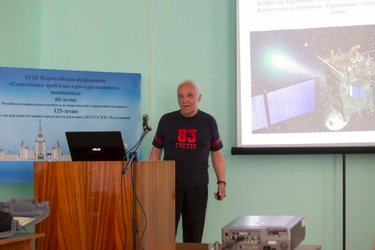
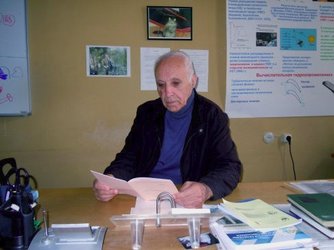
Baranov
Vladimir Borisovich,
Doctor of Physical and
Mathematical Sciences, Professor,
Founder and Head of the Laboratory in 1987–2004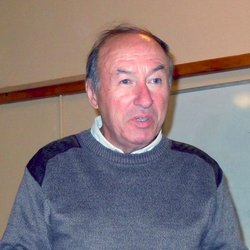
Chalov
Sergey Vladimirovich,
Doctor of Physical
and Mathematical Sciences,
Head of the Laboratory in 2004–2021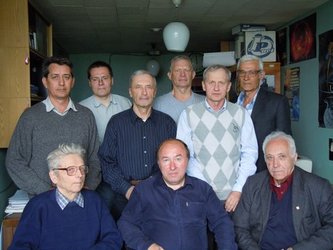
Laboratory staff
Main results
The first axisymmetric kinetic-continual model of interaction between the solar wind and the supersonic flow of partially ionized interstellar hydrogen plasma was developed in the Laboratory The model provided the most adequate description of this physical phenomena. In this model the interaction of the solar wind protons with the charged component of the interstellar medium was described in the framework of continuum mechanics, while the interaction with hydrogen atoms was considered on the basis of kinetic theory. The intersection of the solar wind termination shock (TS) by Voyager 1 in December 2004 and Voyager 2 in August 2007 at distances of 94 AU and 84 AU, respectively, was predicted long before these events with an accuracy of several present using the model developed in the laboratory (Baranov, Malama, 1993). One of the most important results of the model is the prediction of the so-called "hydrogen wall", i.e. the non-monotonic decrease in the number density of interstellar H atoms with a peak near the heliopause (HP). The hydrogen wall was experimentally confirmed by the absorption spectrum in Lyman-alpha from distant stars on the USA spacecraft Hubble Space Telescope in 1996.
This topic is closely related to the work on the interaction of the solar wind with the atmospheres of comets.
A unique numerical 3D nonstationary model of the magnetohydrodynamic flow of partially ionized plasma in the vicinity of comet Churyumov–Gerasimenko was constructed in the laboratory (Baranov, Alexashov, Lebedev, 2015; Baranov, Alexashov, Lebedev, 2019). The dependence of the flow on time was caused by the change in the distance of the comet from the Sun in conjunction with a complex trajectory of the Rosetta spacecraft around of the comet. The results of computations based on this model gave a good agreement with the experimental data.
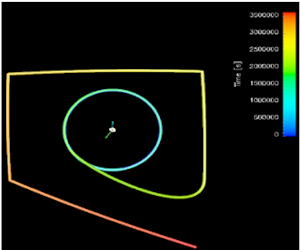
The trajectory of the Rosetta spacecraft
around the comet Churyumov–Gerasimenko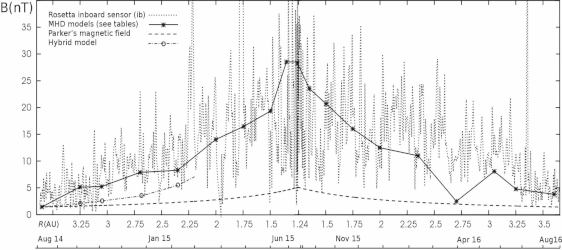
Distribution of the magnetic field
along the trajectory of comet Churyumov–Gerasimenko.
Theory (Baranov, Alexashov, Lebedev, MNRAS, 2019)
and experiment on the Rosetta spacecraft
Laboratory staff take part in experimental research in the field of physical kinetics and scientific instrumentation. These works are related both to the study of atomic collisions in relation to phenomena occurring in outer space, and to the creation of scientific instruments for aerospace vehicles in order to study the structure of the atmospheres of planets, the interplanetary medium, study the Earth by remote sensing from space (Rubtsov, Alymov, Kalinin etc., 2019).
Another direction of activity of the Laboratory is related to the numerical modeling of turbulence flows and heat transfer in two-dimensional channels and three-dimensional unsteady boundary layers on complex-shaped bodies. The most important points are processes of transition from laminar flow modes to turbulent modes (Aleksin, 2008; Aleksin, Zubarev, 2008).
Unsteady two-temperature models of nonequilibrium, multicomponent, reacting mixtures of gas and solid with application to new materials synthesis via combustion and sintering are investigated. The research is done in collaboration with Dr. Igor Filimonov at Merzhanov Institute of Structural Macrokinetics and Materials Science RAS, Russia and Dr. Karen Martirosyan at Advanced Nanoscience Laboratory, University of Texas Rio Grande Valley, USA. (Markov, 2019).
History of the laboratory
The Laboratory of "Physical Gas Dynamics" was formed in IPMech RAS in 1987 as part of the "Cosmic Gasdynamic" department after its transfer from Space Research Institute (IKI) of AN USSR. The department was founded and headed by Academician Georgiy I. Petrov, the first Director of IKI of AN USSR. The department consisted of two laboratories: experimental laboratory of "Physical Kinetics" (head of the laboratory – V.B. Leonas), and the theoretical laboratory of "Physical Gas Dynamics" (head of the laboratory – V.B. Baranov). After the death of Vladas Bronislovo Leonas the experimental laboratory collapsed. In 2004, when V.B. Baranov reached the limit for the head of the laboratory, S.V. Chalov became head it.
The Laboratory is a world leader in theoretical modeling of physical phenomena in space. This leading position is closely related to the pioneering paper by Baranov, Krasnobaev, and Kulikovskiy (Soviet Phys. Dokl., 15, p. 791, 1971). This paper suggested a model of interaction between the solar wind and the supersonic flow of interstellar gas. The supersonic nature of the flow of the interstellar medium in the vicinity of the solar system was confirmed in 1971 by experiments at the USA spacecraft OGO-5.
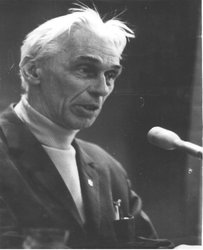
Academician
Georgiy I. Petrov
(1912–1987)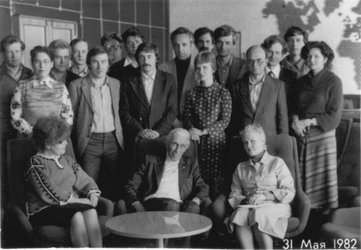
Department of "Space Gas Dynamics"
of the Institute of Space Research USSR Academy
on the day of the 70th anniversary
of Georgy Ivanovich Petrov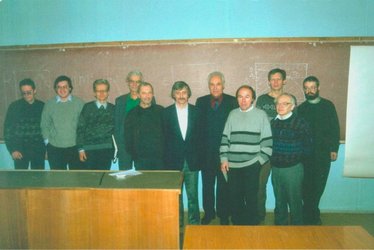
Laboratory of "Physical Gas Dynamics"
in Institute for Problems in Mechanics
of USSR Academy of Sciences, 1990
Cooperations
NASA IBEX (Interstellar Boundary Explorer) project,
Astrophysical Institute of Bonn University,
Institute of Aeronomy French Academy of Sciences,
University of Southern California,
International Space Science Institute in Bern (Switzerland),
Sheffild University,
etc.
Awards
- Baranov V.B.: Order of the Badge of Honour (1971),
- Baranov V.B.: USSR Academy S.A. Chaplygin Award (1982),
- Baranov V.B.: Yu.A. Gagarin Medal (1981),
- Baranov V.B.: USSR Academy G.I. Petrov Medal (2006),
- Izmodenov V.V.: Zeldovich Medal by RAS and COSPAR (2006),
- Izmodenov V.V.: I.I. Shuvalov Award (Lomonosov Moscow State University, 2006),
- Baranov V.B.: M.V. Keldysh Medal (2007),
- Baranov V.B. and Izmodenov V.V.: G.I. Petrov Award (2020).
Main publications
Books
- Baranov V.B., Krasnobaev K.V. Hydrodynamic theory of cosmic plasma. Moscow, Nauka, 1977, 336 p. [in Russian]
- Baranov V.B. Hydro-aerodynamics and Introduction in Magneto-hydrodynamics. Lomonosov Moscow State University Publishing House, 2018. 256 p. [in Russian]
- Rubtsov N.M., Alymov M.I., Kalinin A.P., Vinogradov A.N., Rodionov A.I., Troshin K.Ya. Remote investigation of combustion and explosion processes based on optoelectronic methods. Saratov, Publishing house "KUBik", 2019, 288 p. [in Russian]
- Izmodenov V.V., Kallenbach R. (Eds.) The Physics of the Heliospheric Boundaries. ESA Publications Division, 2006, 413 p.
Papers
On the Problems of Space Research
- Baranov V.B., Krasnobaev K.V., Kulikovskii A.G. A model of the interaction of the solar wind with the interstellar medium // Soviet Phys. Dokl. 1971. V. 15. P. 791-793.
- Baranov V.B., Malama Yu.G.
Model of the solar wind interaction with the local interstellar medium: numerical solution of self-consistent problem
// J. Geophys. Res. 1993. V. 98. P. 15157-16163.
DOI: 10.1029/93JA01171
- Alexashov D., Izmodenov V.
Kinetic vs. multi-fluid models of H atoms in the heliospheric interface: a comparison
// Astron. Astrophys. 2005. V. 439. P. 1171-1181.
DOI: 10.1051/0004-6361:20052821
- Baranov V.B.
Kinetic-Fluid Perspective on Modeling the Heliospheric/Interstellar Medium Interface, Space Science Reviews. 2009. V. 143. Issue 1-4. P. 449-464. DOI:10.1007/s11214-008-9392-6
- Baranov V.B.
On the influence of Hall currents on the magnetic field penetration through tangential discontinuities into unmagnetized plasma under physical conditions of cosmic space
// Astron. Lett. 2013. V. 39. No. 11. P. 792-796.
DOI: 10.1134/S1063773713100010
- Baranov V.B., Alexashov D.B., Lebedev M.G.
Magnetic fields near spacecraft-explored comets: 3D MHD numerical simulation
// Monthly Notices of the Royal Astronomical Society. 2015. V. 449. P. 2268-2273.
DOI: 10.1093/mnras/stv448
- Baranov V.B., Alexashov D.B.
Influence of the magnetic field on the density distribution of solar wind protons and cometary ions in the shock layer ahead of cometary ionospheres
// Astron. Lett. 2017. V. 43. No. 2. P. 126-133.
DOI: 10.1134/S1063773717020013
- Baranov V.B., Alexashov D.B., Lebedev M.G.
MHD simulation of the solar wind flow around the coma of comet Churyumov-Gerasimenko during Rosetta's flyby
// MNRAS. 2019, V. 482. Issue 4. P. 5642-5650, 2019
DOI: 10.1093/mnras/sty3080
- Belov N.A.
Instability of tangential discontinuity in a plane flow with critical point
// Izv. RAN, Mech. zhidkosti i gaza. 1997. N 2. P. 78-82 [in Russian]
[elibrary]
- Belov N.A.
Plasma flow in vicinity of the heliopause stagnation point in the presence of hydrogen neutral atoms
// Astron. Lett. 2010. V. 36. P. 144-149.
DOI: 10.1134/S1063773710020064
- Chalov S.V., Alexashov D.B., McComas D., Izmodenov V.V., Malama Y.G., Schwadron N.
Scatter-free pickup ions beyond the heliopause as a model for the Interstellar Boundary Explorer ribbon
// Astrophys. J. Lett. 2010. V. 716. P. L99.
DOI: 10.1088/2041-8205/716/2/L99
- Chalov S.V.
Temperature of electrons downstream of the solar wind termination shock.
MNRAS. 2019. V. 485. Issue 4. P. 5207-5209.
DOI: 10.1093/mnras/stz686
- Chalov S.V.
Kelvin–Helmholtz instability of velocity tangential discontinuity in partly ionized plasma with charge exchange.
MNRAS. 2019. V. 482. Issue 2. P. 1664-1669.
DOI: 10.1093/mnras/sty2750
- Chalov S.V., Malama Yu.G., Alexashov D.B., Izmodenov V.V.
Acceleration of interstellar pickup protons at the heliospheric termination shock: Voyager 1/2 energetic proton fluxes in the inner heliosheath.
MNRAS. 2016. V. 455. Issue 1. P. 431-437.
DOI: 10.1093/mnras/stv2323
- Izmodenov V.V., Alexashov D.B.
A model for the tail region of the heliospheric interface
// Astron. Letters. 2003. V. 29. P. 58-63.
DOI: 10.1134/1.1537379
- Izmodenov V.V., Alexashov D.B.
Magnitude and direction of the local interstellar magnetic field inferred from Voyager 1 and 2 interstellar data and global heliospheric model.
Astron. and Astrophys. 2020. V. 633. Id. L12.
DOI: 10.1051/0004-6361/201937058
- Malama Y.G., Izmodenov V.V., Chalov S.V.
Modeling of the heliospheric interface: multi-component nature of the heliospheric plasma
// Astron. Astrophys. 2006. V. 445. P. 693-701.
DOI: 10.1051/0004-6361:20053646
On the Problems of Aerodynamics
- Aleksin V.A.
Simulation of the effect of high-intensity turbulence flow parameters on unsteady boundary layer with streamwise pressure gradients
// Fluid dynamics. 2008. V. 43. No. 2. P. 274-286.
DOI: 10.1134/S0015462808020129
- Aleksin V.A., Zubarev V.M.
Modeling of influence of parameters of turbulence of an incident flow on wall transition streams in the boundary layer
// Matematicheskoe modelirovanie. 2008. V. 20. P. 87-106 [in Russian]
[link]
- Markov A.A., Filimonov I.A., Martirosyan K.S.
Two-Temperature Model and Simulation of Induced Electric Field During Combustion Synthesis of Zinc Sulfide in Argon
// International Journal of Thermophysics volume. 2019. V. 40. No. 1. Id. 6.
DOI: 10.1007/s10765-018-2469-x
